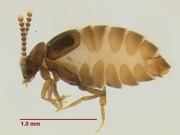| Aleocharinae Temporal range: Earliest Cenomanian–Holocene, | |
|---|---|
 | |
| Aleochara lanuginosa | |
| Scientific classification | |
| Kingdom: | Animalia |
| Phylum: | Arthropoda |
| Class: | Insecta |
| Order: | Coleoptera |
| Suborder: | Polyphaga |
| Infraorder: | Staphyliniformia |
| Family: | Staphylinidae |
| Subfamily: | Aleocharinae Fleming, 1821 |
| Synonyms | |
| |

The Aleocharinae are one of the largest subfamilies of rove beetles, containing over 12,000 species. Previously subject to large-scale debate whether the subfamily deserved the familial status, it is now considered one of the largest subfamilies of rove beetles. [3] [4]



